
Adolf Hitler's Toilet
How Adolf Hitler's Toilet Ended Up in an Auto Repair Shop in a Small Town in New Jersey
Adolf Hitler led Germany into a violently self-destructive 12 years of genocidal insanity, starting with his appointment as Reichskanzler in January 1933. Hitler wanted to establish a thousand-year Reich (or Reign) of German domination over the "lesser peoples" of the world. He ended up with a coward's death, strung out on a cocktail of amphetamines, cocaine, opiates, and other drugs while cowering in a bunker, shooting himself while the Soviet Red Army captured Berlin on the last day of April, 1945. The only throne he ever occupied was a lowly ceramic one that came to sit under a workbench in an auto repair shop in a small town in New Jersey. Which, of course, I visited.
Why did Hitler's commode, the Führertoilette, end up in a garage in New Jersey?
Because the official German state yacht was scrapped there.
The Aviso Grille became the official State Yacht of the Third Reich and Hitler's official maritime vessel in 1935. Hitler had dreams of sailing up the Thames River to London in the German state yacht to accept the surrender of Britain. Then he would live in Windsor Castle. He had it all planned in detail. During the war, the Grille was put into combat. The ship was seized by the U.K. after the war and then sold to private owners in the U.S. in 1947. It was scrapped in 1951, with smaller parts sold first and the hull broken up later that year. Many components, including some of the plumbing, can be found around Trenton and elsewhere in New Jersey and surrounding areas. One toilet (or head, to be precise) was simply installed in an automotive repair shop to carry out its original intended function. Greg Kohfeldt came to own the shop and its notorious fixture.
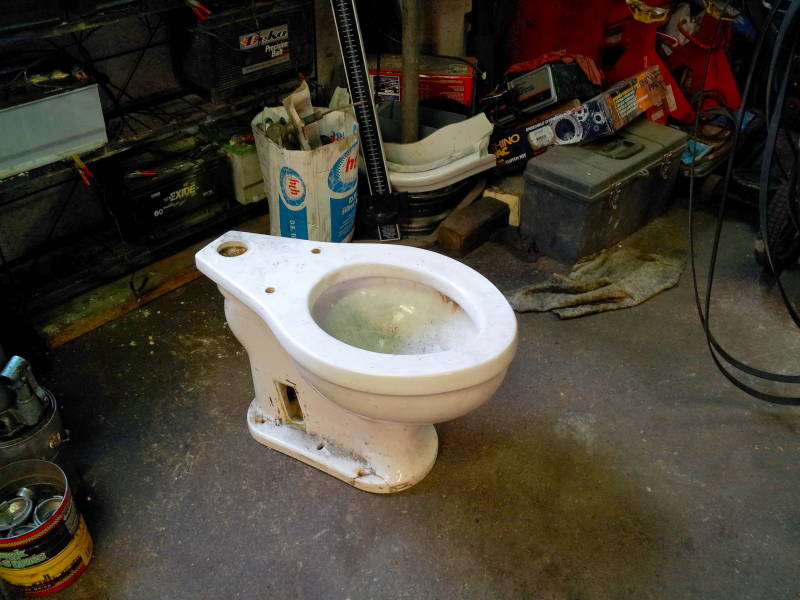
And if this page is about a toilet from Hitler's yacht, why don't I refer to the fixture as Hitler's head? Because a page titled "Adolf Hitler's Head" sounds like it's going to describe how the Soviet Red Army transported a gruesome war trophy back to Moscow and the secret archives in the Lubyanka on Dzerzhinskaya Square.
Update: I visited in September 2014. In January 2015, Greg sold the toilet and the broken sink seen below. Hitler's toilet is no longer at the garage.
According to this Tablet article from 20 April 2015, "a gentleman from a British TV show visited his shop in January to purchase the toilet as well as the remains of the sink. He doesn’t remember the name of the television program but believes it was affiliated with Discovery UK, perhaps entitled ‘War Treasures.’ (No television series currently exists with that name.)" Apparently Greg made enough from the sale to put a new bathroom in his garage.
However, as described on this page:
Who Bought Hitler's Toilet?
that article seems to confuse the January 2015 sale
with some aspects of a planned television appearance
in 2012.
Aviso Grille, Hitler's State Yacht
An aviso or adviso was a small boat designed to carry orders, in English we would call it a sloop or a dispatch boat. They are described in the Dictionnaire de la Marine Française 1788 – 1792, dating from a pre-radio era when they were commonly used to carry messages. By World War I, French avisos had grown to a displacement of 300 to 700 tons, typically armed by two to four 100 mm or 138 mm guns. By the 1930s they had grown larger, the Portuguese Navy built avisos with up to 2,400 tons displacement. They continued to grow in size. NATO now classifies a typical one as a corvette.
The Reichsmarine, as the German Navy was known during the period 1919 to 1935, ordered an aviso-class vessel to serve as the Flottentender "C" or Fleet Tender "C". The Blohm & Voss shipyard laid down its keel at their shipyard in Hamburg in June, 1935. The vessel was commissioned in May, 1935 as the German State Yacht, the Aviso Grille. (which makes it the Corvette Cricket)
Nazi U-boat toiletsIt was 135 meters long overall, 115 meters long at the waterline, with a beam of 13.5 meters and a draft of 4.2 meters. In its standard official state yacht configuration it displaced 2,600 tons. It was the largest private yacht in the world at the time, larger than even J.P. Morgan's Corsair. It was converted to military operation in 1939, with a fully loaded combat displacement of 3,490 tons.
The ship had a top speed of 26 knots. Fuel stores provided a cruising range of 9,500 nautical miles or 17,600 kilometers.
Hitler suffered from seasickness, he didn't spend an enormous amount of time on board. He made sure that his girlfriend Eva Braun had her own cabin, so he did spend some time on board the Grille now and then. Perhaps his nausea kept him close to this toilet.
The 2010 book
Was Hitler Ill? A Final Diagnosis
by Henrik Eberle and Hans-Joachim Neumann,
a historian and a professor of medicine,
lists the 82 medications Hitler took and
analyzes his myriad medical ailments and obsessions.
Hitler had severe digestive problems including
uncontrollable flatulence.
In an attempt to manage the flatulence, his massive drug
regimen included a drug containing the nerve agent strychnine,
which is also used as rat poison.
His digestive problems would have kept him
close to the head while on board.
As would, of course, all the vomiting.
Medicating a Madman:
A Sober Look at Hitler's Health
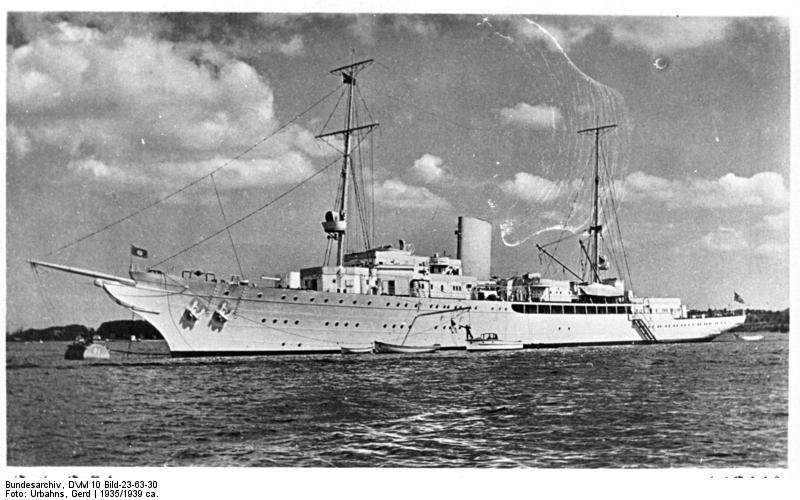
In May 1936, Hitler and Admiral Erich Raeder were known to be on board for a naval fleet parade off the shore of Laboe, northeast of Kiel on the Baltic Sea. The occasion was the dedication of the Laboe Naval Memorial, a 72-meter tower honoring the members of the Kaiserliche Marine, Germany's navy, killed during World War I.
The Grille did make it to England one time. In October 1937 it transported a delegation of the Wehrmacht, Germany's unified military forces, to the coronation of King George VI and Queen Elizabeth.
World War II broke out with Germany's invasion of Poland on the first day of September, 1939. The Grille was converted to military operations, and was initially used to lay mines off the coast of France. 228 mines could be stored on board.
After the French mining missions, it was used as a patrol ship and gunnery training ship in the Baltic Sea. It was equipped with three five-inch guns and some 37 mm and 20 mm anti-aircraft guns. The large weapons were 12.7 cm SK C/34 naval guns. They fired a 28 kilogram high-explosive shell at a muzzle velocity of 830 meters per second out to a range of 17,400 meters. SK designated Schnelladekanone or quick loading cannon, they could fire up to 15 to 18 rounds per minute. C/34 means Construktionsjahr, the design dates from 1934.
The anti-aircraft guns were four 37 mm SK C/30 units with an effective ceiling of 2,000 meters or 6,600 feet and a maximum range of 8,500 meters, plus four 20 mm anti-aircraft guns.
Germany invaded the Soviet Union in 1941 and the Grille did more mine-laying. It was then transferred after June 1942 to Narvik, Norway, where it served as the command ship for the Arctic U-boat fleet commander.
By the end of the war the Grille was at the headquarters of Großadmiral Karl Dönitz. This was at the Naval Academy in Mürwik. Dönitz stood on the deck of the Grille on 1 May 1945 as he announced Hitler's death and his assumption of command of Germany and its military. Dönitz's supposedly grand reign was limited to a small area around his headquarters, and was mostly occupied with his efforts to make sure German forces surrendered to the British and American forces and not to the Soviets. This went on for the final week remaining until Germany's surrender, which was signed on the 7th in Reims, France, and on the 8th in Berlin.
The Aviso Grille Comes to New Jersey
The British Royal Navy seized the Grille at the end of the war. It was sold in 1947 to private owners in the U.S., ending up at Harry Doan's shipyard in New Jersey. On the one hand, Doan agreed with the U.S. federal government that nothing should become a memorial to Hitler. But at the same time, he was illegally charging visitors 25 cents each to tour the yacht. The government stepped in and said it was time to destroy the Nazi state yacht.
Harry Doan began scrapping the Grille in 1951, first selling smaller pieces. Furniture, pieces of teak decking, portholes, and this toilet.
Sam Carlini was a close friend of Doan, and Sam's auto repair shop in the small town of Florence needed a toilet. Doan had a very functional toilet and sink available for a low price. Sam installed it in his garage in 1952.
Carlini sold his auto repair shop in 1994 to Greg Kohfeldt, who didn't care one way or the other about where the plumbing came from. It was just a functioning toilet which had been in service in the garage since before Greg was born.
Hitler's Toilet at the Garage
Greg's Auto Shop is at 437 West 2nd Street in Florence, New Jersey. Turn off U.S. Highway 130 to go northwest on Delaware Avenue, New Jersey route 656. Almost two miles from the highway you pass through the center of the small town of Florence. Three blocks past the town park and boat ramp, turn left on Winter Street and then immediately turn right on West 2nd Street. Greg's shop is right before the next corner.
I had the opportunity to visit in September 2014, when I was teaching a Linux server course to Merrill Lynch at their large facility north of Trenton. I got everything set up by shortly after noon on Monday, so I had the rest of the afternoon free to drive down to Florence.
In this picture I have gone past the shop, turned around and parked, and am now looking back east along 2nd Street.
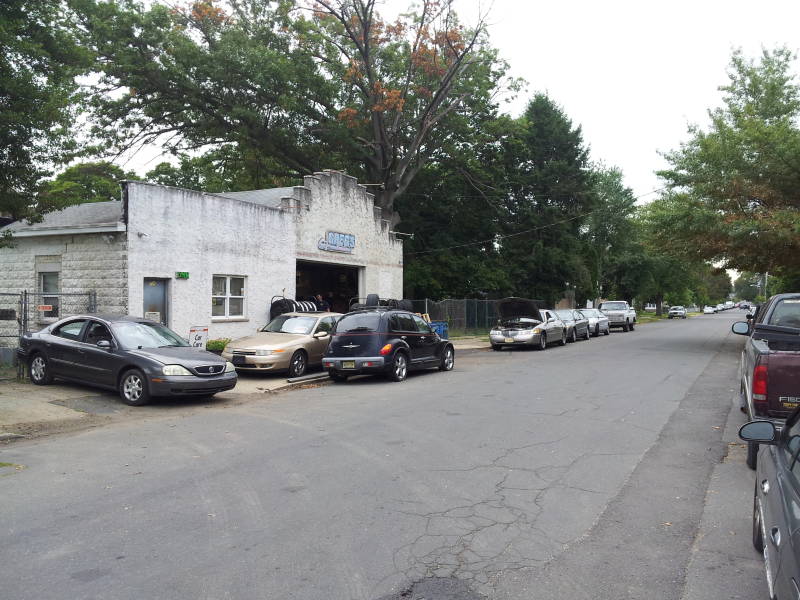
If he wasn't busy, Greg could talk to you about his odd object of interest. If you walked in the garage door with a camera, he would say "The toilet is over there" and point you to the bench along the left side of the garage. He'll get to you when he can.
How did I know how to find Hitler's toilet?
Look, this isn't really an obsession of mine. I don't sit up late at night searching the Internet for information on insane mass murderers. Nor do I plan trips around obscure pieces of plumbing.
What happens is that I get an opportunity to do some enterprise-scale Linux work for a major financial institution in a region I've never visited before. That sounds very interesting in several ways at once, none of which involve toilets.
Do I then immediately rush to Google to search for:
new jersey toilets
or whatever?
No.
What happens is that I recalled that within the past six to twelve months at least three different people had sent me detailed messages about how I absolutely must go to some place in New Jersey and see Hitler's toilet, and here are links to several web pages they have spent who knows how much time reading.
Supposedly I'm the obsessed one in all this...
OK, I'll be in the Trenton area. If I can get an early start my first day there, and the shipping works out smoothly, and I can get everything set up reasonably quickly, then I should have most of the afternoon and a rental car available for exploration.
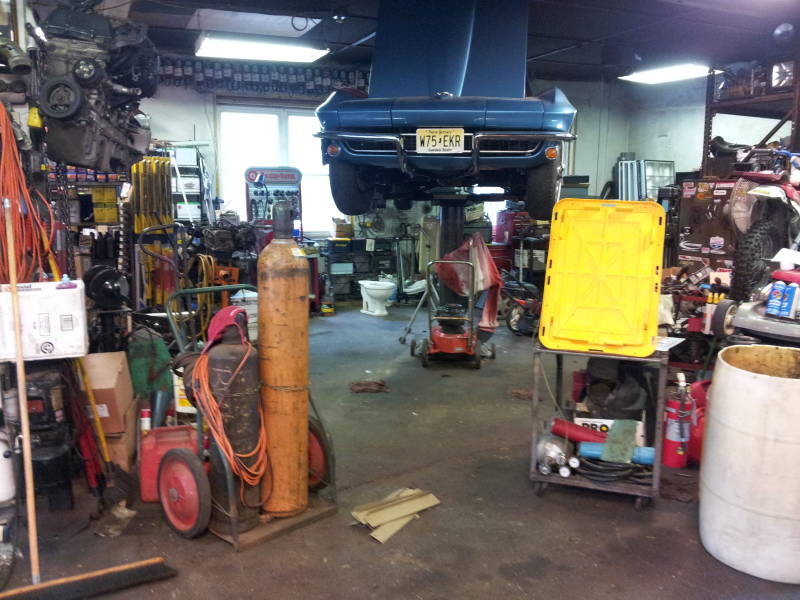
It's no museum, it's a working auto repair shop. There happened be an unexpected ceramic fixture off to the side, but there was a lot of the clutter you find in a busy garage and it sort of blended in.
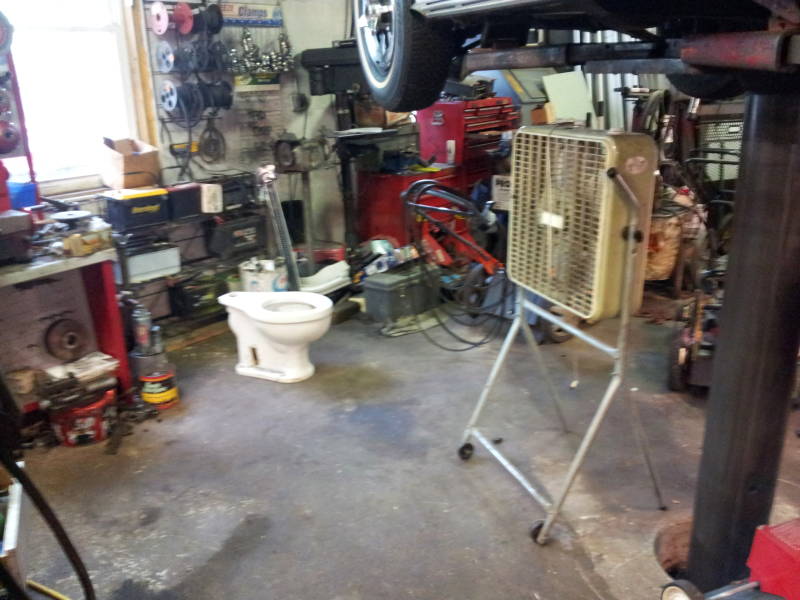
The toilet was in operation in Greg's garage with no cleaning, ever, since its installation in 1952 until 2012. You might be able to imagine its condition after 60 years of uncleaned operation in a garage, but then again your imagination might fall short here. The description at RoadsideAmerica.com includes some pictures from when it was in service.
Why the end of operation in 2012?
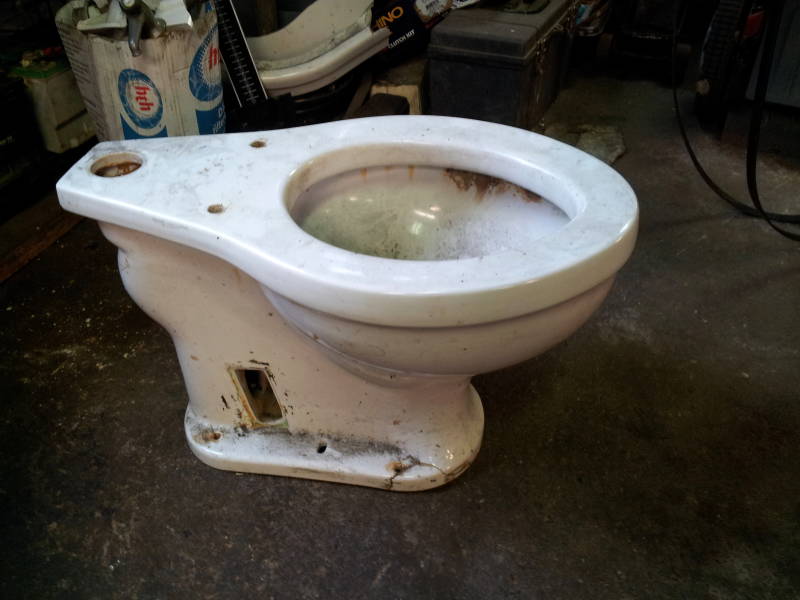
The makers of the British television show Four Rooms, similar to the U.S. Antiques Roadshow, offered to fly Greg, the toilet, and the sink to London to appear on an episode. Free airfare, free shipping for the fixtures (it turns out that you can't take toilets and sinks as either carry-on or checked baggage given their size and weight), plus a week in a hotel in London.
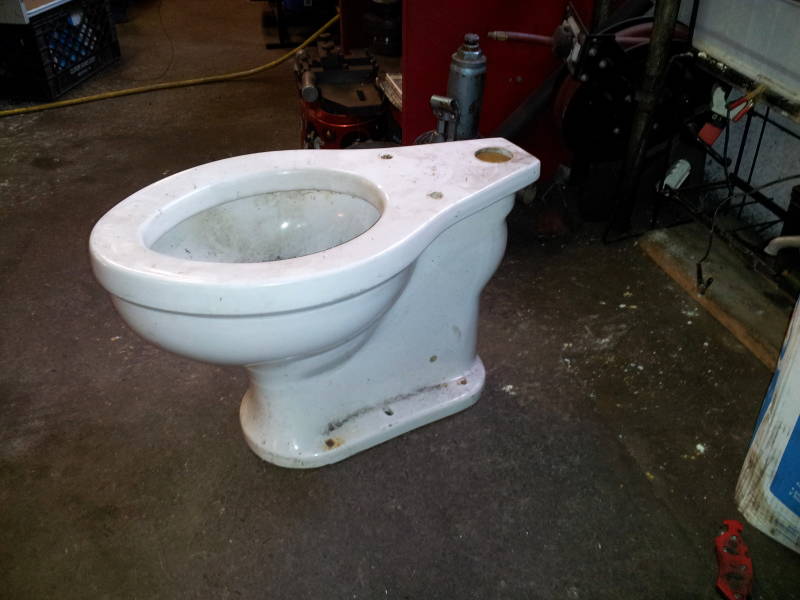
The TV show was supposedly going to sell the toilet to the highest bidder. The episode was never aired and the toilet wasn't sold, but hey, it was a free trip to London for a week.
The sink was broken into several pieces while being shipped back, they were in a blue-and-white cardboard box beside the toilet.
Greg came over and we introduced ourselves. He pulled the toilet and box of sink parts out from underneath the bench, said "Take all the pictures you want", and went back to showing to a customer why his car, up on the lift, needed certain repairs.
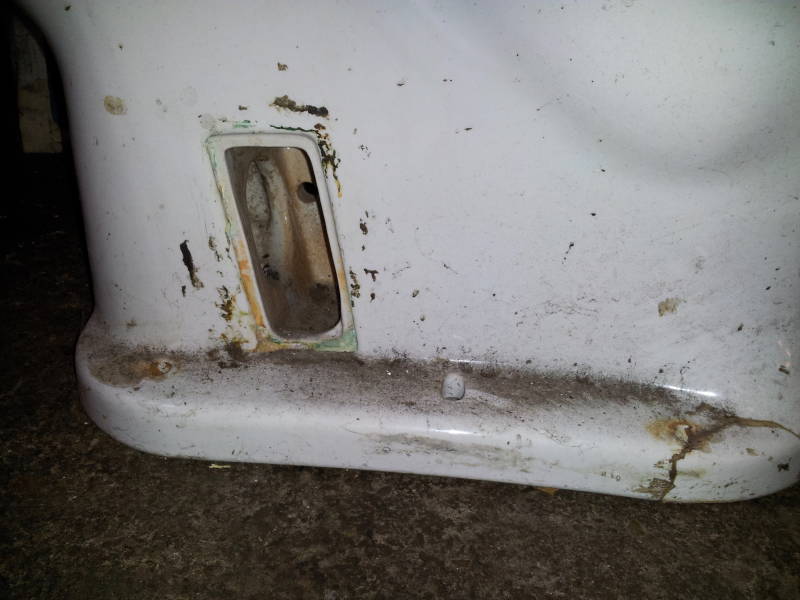
I enjoyed my brief visit with Greg. He had cars to fix and business to do. The lavatorial relic had nothing to do with that, and I didn't want to get in his way. Hence no picture of him and me with this Teutonic Throne. But during that brief visit I got the idea that he and I have experienced the same odd obsessions from the media.
Notice the open slot on the side, used on ships' heads of this vintage and general design to pump in seawater. Also notice that it has six bolt holes rather than the usual four. That is said to be a characteristic of ships' commodes, I suppose to better distribute the strain when occupied during heavy seas.
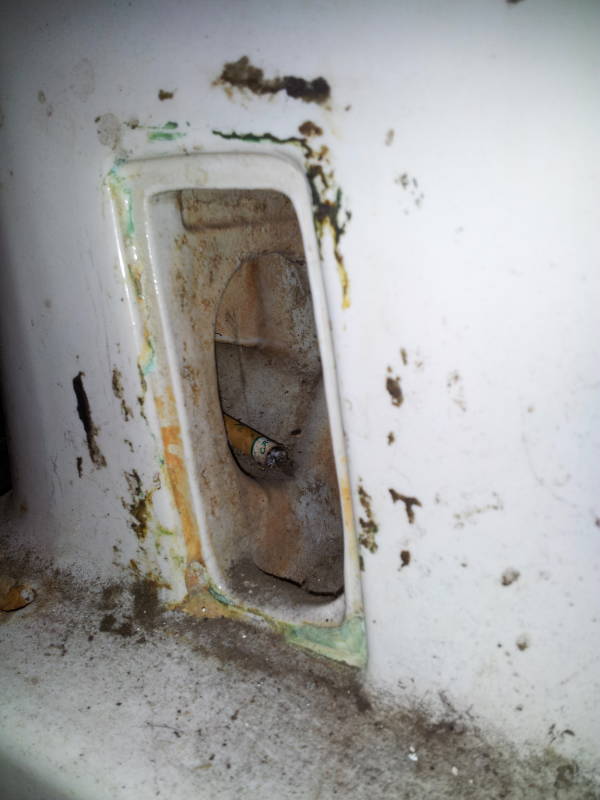
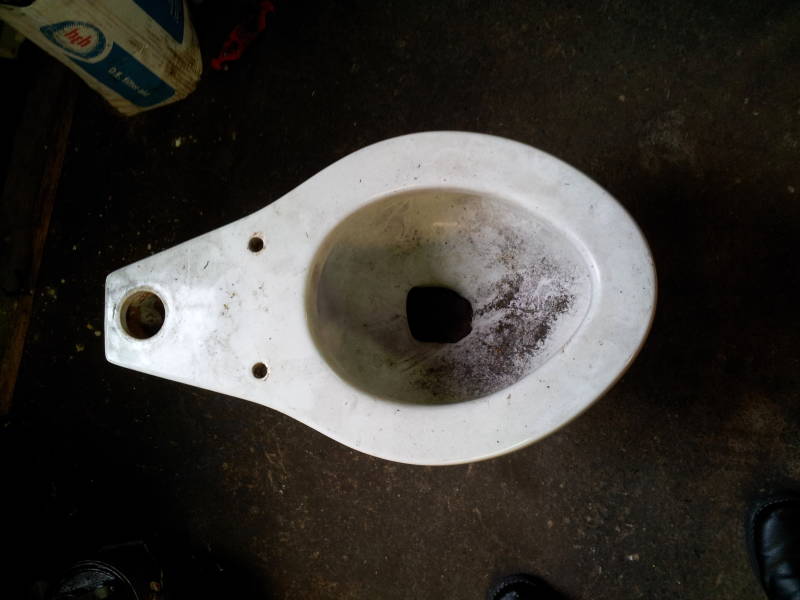
One of the on-line articles I read before arriving, either the one in The Atlantic magazine, or the one in Tablet magazine, or the one at RoadsideAmerica.com, described him as "bemused" by the attention. I think that's exactly the right word.
Portraits of Auto Mechanics in the Style of Renaissance PaintingsHe likes working on cars, that's what he does, and while people from all around the world visit his garage, that mostly just amuses him. The Florence area has a lot of bits and pieces from the Grille, and this fixture is just another surplus piece that's been around for a long time. Why do people from Europe, Japan, Australia, and elsewhere hunt down his shop to see this thing?
Until the UK television show contacted him, the toilet was still fastened to the floor the same as it had been when he bought the shop. The offer of the free trip to London for a week convinced him to unfasten it and put in a replacement.
It was only then that he discovered that it wasn't really bolted down. The bolts through the floor mounting flange had rusted off, and it was cemented to the floor.
This came up during the interview and the television show hosts latched onto what they thought was Greg's questionable behavior. "Why in the world was it just cemented to the floor? Why hadn't you properly bolted it down?" Look, it was that way when I bought the garage, there was no indication of how it was fastened down, but it was fastened down and it worked just fine that way.
Then they continued, "But if it worked, then why did you unfasten it?" Uh, you invited me to London with all expenses paid so long as I pried it loose and brought it along.
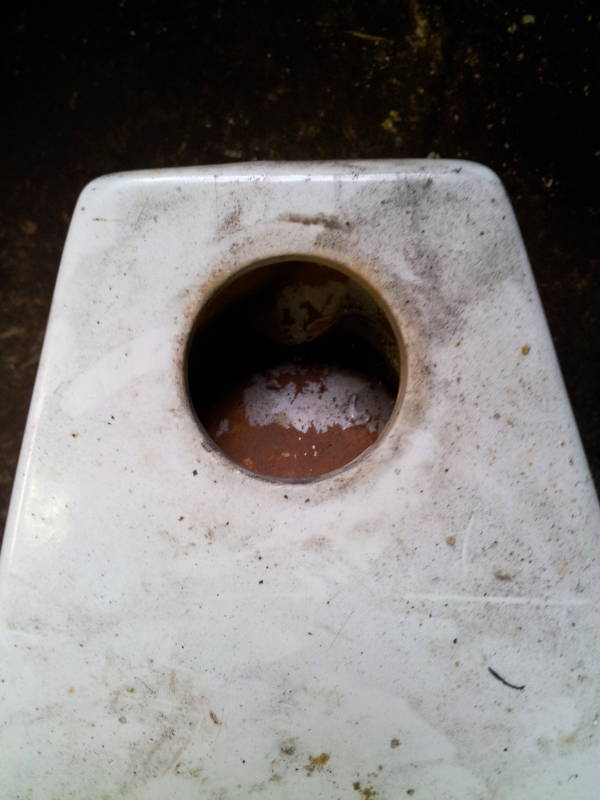
It very much reminded me of when I was contacted by a writer at the BBC about this site. Once on the phone he started asking me about what he seemed to think was my strange behavior. "Why would you have such a web site? What makes you think that people would be interested in such a strange thing?"
I said that I was just the guy with an intentionally goofy page spun off a collection of travel pictures and stories, that one page now turned into an entire site and maintained for the advertising revenue. But then I'm just a guy with a silly web site. I don't do this full time. I don't think it's especially important. I do consulting work and write and teach courses about Linux and networking and cybersecurity.
What interests me now is why a serious organization like the BBC thinks that this is a story worthy of coverage. What makes my collection of bizarrely specialized travel pictures something that the viewers, listeners, and readers of the BBC need to know about? Why do you think it's important enough to cover?
There are exceptions!
Peček Mitja of Radio Slovenia,
BBC 5's live Drive show,
along with others,
have asked insightful questions
and been a pleasure to talk with.
Interviews
Contact
I usually get a question of that form when I'm contacted by the media, and I can never help but honestly answer with a question along those lines. And with few exceptions, The Media is not happy to be asked that question. They seem to have the attitude "You're the freak here, and we're asking the questions."
The analogous situation for Greg would be the visitor who has just traveled hundreds if not thousands of miles to look at Hitler's toilet, and then wants to berate the guy who bought the garage where it happened to be cemented to the floor for having an odd obsession.
It wasn't just the toilet and sink that found its way into mundane settings in the region surrounding Florence. Greg told me about the table now at American Legion Post #194 in Florence, along with other furniture scattered here and there. Many people in the area have an old flagpole that once flew the Kriegsmarine swastika banner on the Grille. "It was Hitler's yacht, there were a lot of flagpoles."
One man used the teak decking off the Grille to build a deck at his vacation home down at the coast. It was still in good shape at least into the early 2000s. Portholes have been used as small decorative windows in area houses.
Harry Doan was free to sell any pieces as long as they didn't bear a swastika or other Nazi iconography. The scrapping project became a boon for local home renovation and decoration projects. All the useful pieces had been distributed by late 1951, and the hull of the ship was broken up for scrap metal.
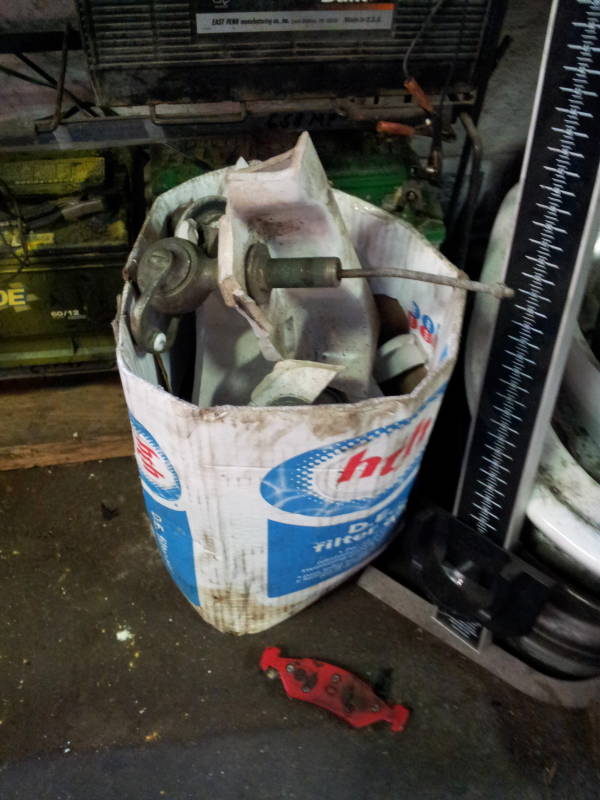
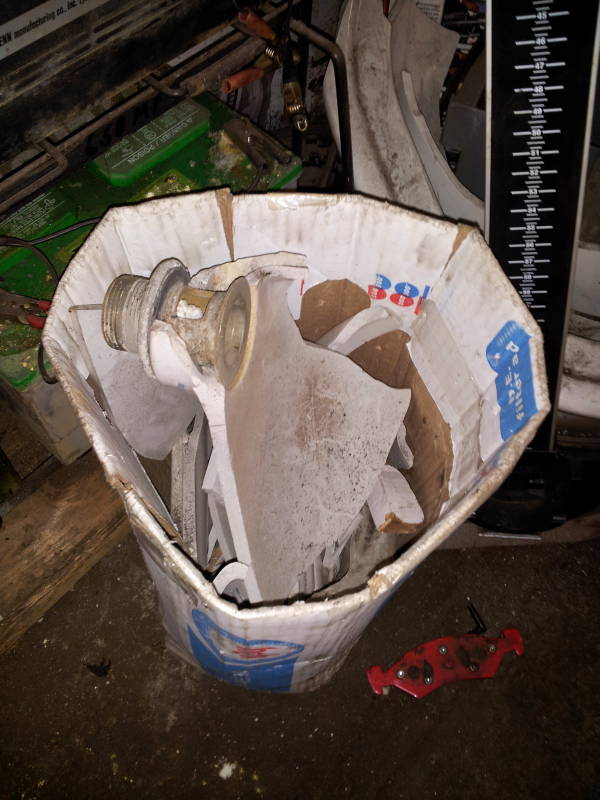
Font historians could place the construction of the faucet handles within a specific time period. A number of Blackletter or Gothic typefaces were developed in Europe beginning around 1150. Far more readable typefaces were developed and used throughout Europe in the 15th and 16th centuries, but Germany stuck with the prötö-heavy-metal Fräktür. Thanks to Unicode I can show you:
𝕱𝖗𝖆𝖐𝖙𝖚𝖗 𝖑𝖔𝖔𝖐𝖘 𝖑𝖎𝖐𝖊 𝖙𝖍𝖎𝖘.
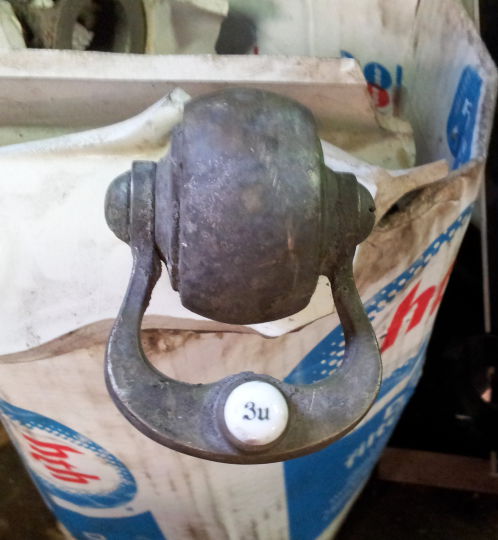
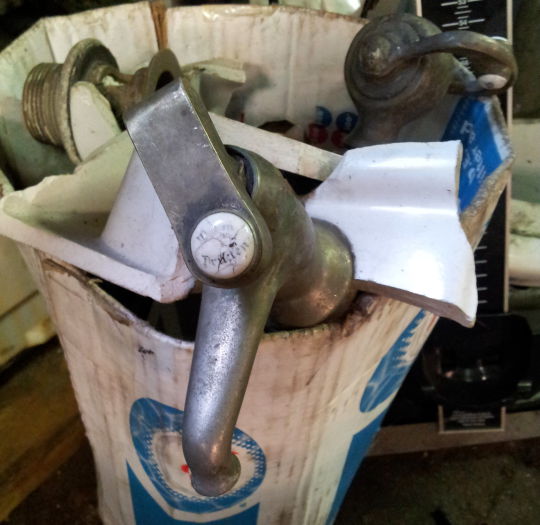
Before the 19th century, intellectual texts in Germany used readable Antiqua-style typefaces for Latin text and the ornate Fraktur for German text.
Napoleon dissolved the Holy Roman Empire and occupied Germany in 1806. German nationalists began trying to define "true German cultural values." This led to claims that readable Antiqua typefaces were "not serious" and therefore "un-German", and that Fraktur showed supposed German traits of depth and sobriety. This led to a debate in the Reichstag in 1911 about whether Antiqua should be made the official typeface of Germany.
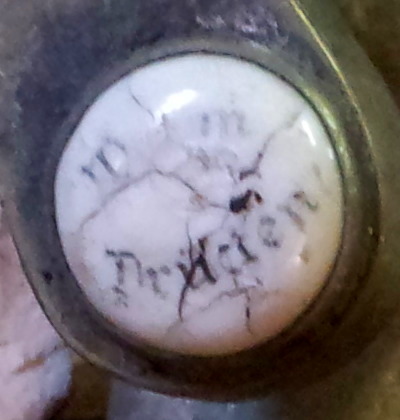
The Nazi regime took this further, claiming that Fraktur represented some mythical Gothic tradition and therefore was a "pure German script". Non-Fraktur typefaces were called "Roman characters under Jewish influence".
𐌼𐌴𐌽𐍅𐌹𐌻,
𐌰𐌺𐍄𐌿𐌰𐌻
𐌲𐍉𐌸𐌹𐌺
𐌻𐍉𐍉𐌺𐍃
𐌻𐌹𐌺𐌴
𐌸𐌹𐍃.
(Meanwhile,
actual Gothic
looks like this).
The famous typographer Jan Tschichold, who had the audacity to design clean and easily readable sans-serif fonts, was arrested and accused along with his wife of collaborating with communists in March 1933, just ten days after the Nazis took power. The Gestapo seized and burned all the copies they could find of books he had written. A sympathetic policeman helped him and his family to escape from the madness of Nazi Germany to Switzerland in August of 1933.
However, Hitler did not like Fraktur and took time out of his busy schedule to berate the Reichstag about fonts in 1934:
A Schrifterlass or "edict on scripts" was issued by Hitler's personal secretary Martin Bormann in 1941. It banned the Fraktur typeface as Schwabacher Judenlettern or "Schwabacher Jewish letters". Ironically, the Nazi party letterhead on the official edict was itself in the now banned and supposedly Jewish typeface.
Now it's mostly the Ämïsh and Öld Ördër Mënnönïtë communities of German immigrants to North America who routinely use the Fraktur script. Well, the Ämïsh and Öld Ördër Mënnönïtës plus heavy metal bands. Plus whoever designed the signs at Dïsnëyländ and Dïsnëywörld. (the first of which contains a replica of a castle built by a mad Bavarian prince)
Peaceful Florence
Florence Township has a population of just over 12,000 people. The town was organized in 1849 when a hotel and steamship wharf was built. An iron foundry was built along the river in 1857. By 1900 that foundry employed much of the local workforce.
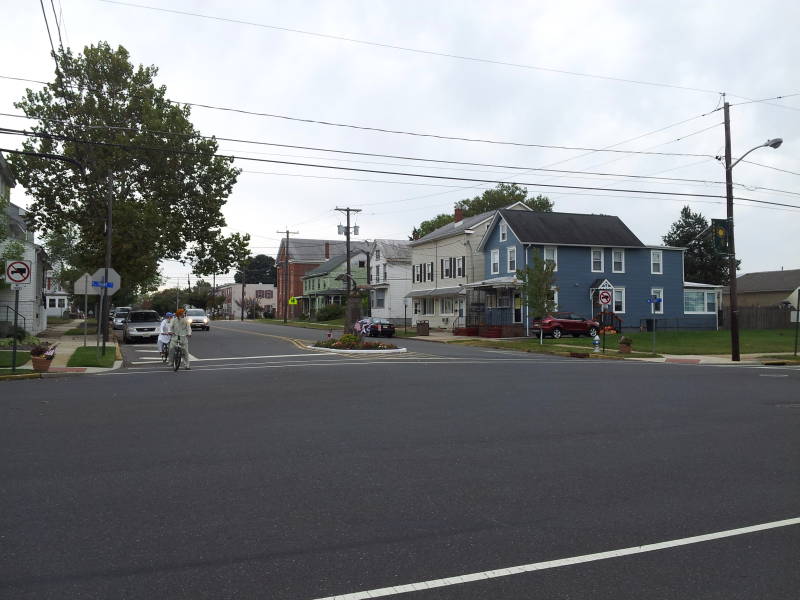
Florence is defined not as a town but as a township, which works a little differently in New Jersey. In the rest of the U.S., a township is a part of a county and many have municipalities within them. In New Jersey, a township is a form of municipal government, just like a village, town, borough, or city. The part of Florence along the river is built up in a way that makes me call it a town, with a grid of streets and regularly spaced lots. The southern two-thirds or more of the township is "out of town", with forests and highways.

Florence sits beside the Delaware River dividing New Jersey from Pennsylvania. The river continues south past Pennsylvania where it becomes broader and broader as it turns into the Delaware Bay and opens into the Atlantic Ocean.
The Delaware River is navigable by freight shipping at least as far north as Trenton, supporting industry in that now very grim city.
From Camden south to where it forms Delaware Bay, the main navigational channel is being deepened to 45 feet. Many large refineries process petroleum products along the lower Delaware.
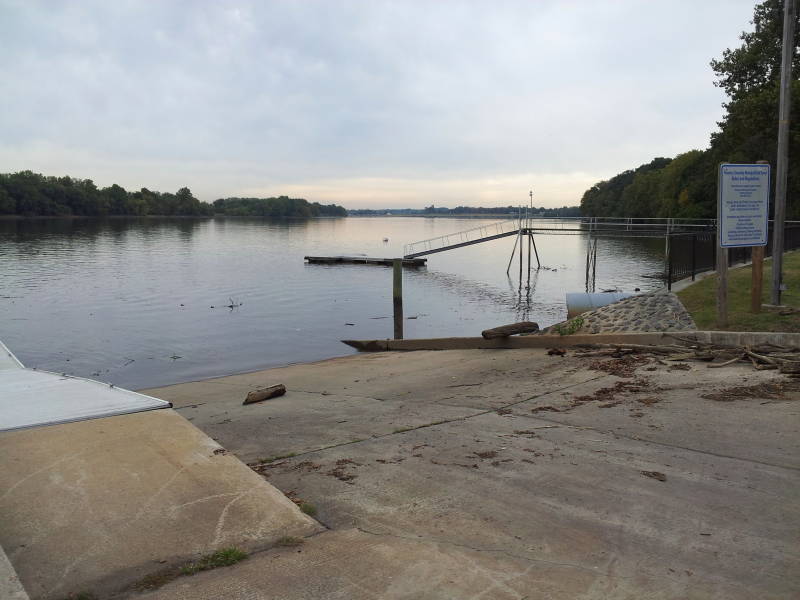
We're down at the boat ramp in the town park, looking first up the river toward Trenton and then down the river toward Philadelphia and the ocean.
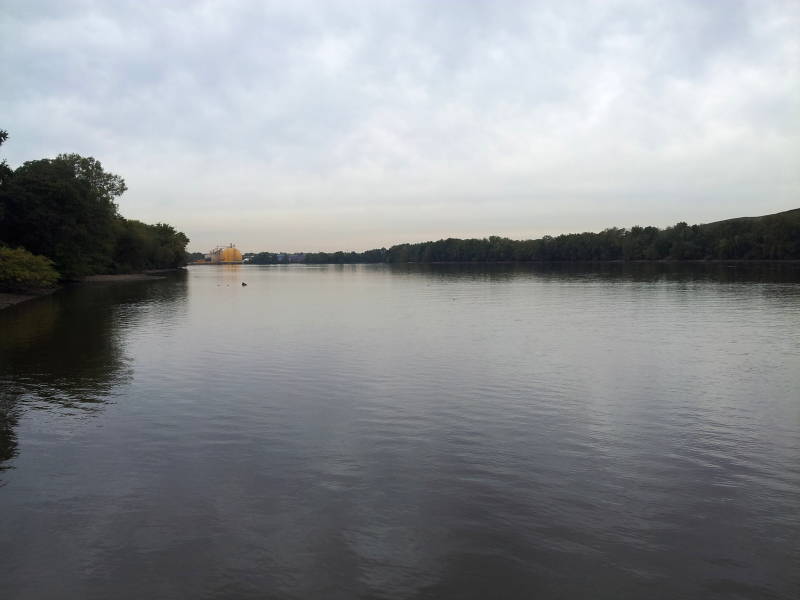
The Banality of Hitler's Commode
Before 1066, English common law had the concept of a bane. This was an animal or object which had caused serious damage, injury, or death. A bane was handed over to the victim, with a sum of money called wergild paid to the survivors in the case of death. If someone's horse kicked you, then you got the horse. If the kick killed you, your survivors got the horse and some money.
This was changed after the Norman Invasion to the deodand, derived from the Latin phrase deo dandum meaning "to be given to God." A deodand was a thing forfeited to God and made ownerless because it had caused someone's death. If a tree or haystack fell on someone and killed them, then that thing was made deodand and was sold to the royal crown which would then apply the profits to a pious cause. Of course this "pious cause" would often be the crown itself. The practical reality was that a jury would decide that the deadly animal or object had a certain value, and its owner had to pay a fine equal to that value. The American Supreme Court Justice Oliver Wendell Holmes wrote of this legal tradition in 1881: "If a man fell from a tree, the tree was deodand. If he drowned in a well, the well was to be filled up."
The deodand legal model was commonly used through the 13th century in England, and continued at decreasing frequency through the 16th and 17th centuries. The spectacular multi-fatality accidents made possible by early railroad operations led to the Fatal Accidents Act of 1846 and the Deodands Act of 1846, the second of which formally abolished the deodand mechanism.
The subtitle of a book about Adolf Eichmann coined the phrase "The banality of evil". Hitler caused the deaths of millions of people. But his possessions weren't made abstractly ownerless deodands, relics of his evil; they became very mundane objects. Deck planking, flagpoles, a garage toilet, some small windows, collections of brass screws, and other useful odds and ends. Megalomaniacs deserve to be disregarded. To the residents of Florence, Hitler is no one special.
He's just the psychopath who used to own the toilet that ended up at the garage.
